Navigation
Install the app
How to install the app on iOS
Follow along with the video below to see how to install our site as a web app on your home screen.
Note: This feature may not be available in some browsers.
More options
Style variation
-
Congratulations MintJulep on being selected by the Eng-Tips community for having the most helpful posts in the forums last week. Way to Go!
You are using an out of date browser. It may not display this or other websites correctly.
You should upgrade or use an alternative browser.
You should upgrade or use an alternative browser.
JAL A350 burns at Haneda Airport after collision on runway 15
- Thread starter hokie66
- Start date
- Status
- Not open for further replies.
Murph 9000
Computer
The thing is you need to be really careful about the implementation of any automated shutdown and triggering of the fire bottles. It's something where a false trigger could be disastrous. For example, a compressor stall / surge might generate enough fire to trigger sensors, but the engine might still be capable of operating at reduced thrust. You really don't want the FADEC going all HAL 9000 about letting the pilots decide what's best for the engines most of the time.
Alistair_Heaton
Mechanical
You don't want engines to shut down automatically.
We had this last year on the A220 after landing.
If the aircraft has a thrust control error flag triggered in flight. On touch down both engines will shut down. Which if the Apu isn't running means the only electrical power is the batteries. The brakes are electrical servo brakes and the batteries have suprising small capacity so the clock starts ticking...
We had this last year on the A220 after landing.
If the aircraft has a thrust control error flag triggered in flight. On touch down both engines will shut down. Which if the Apu isn't running means the only electrical power is the batteries. The brakes are electrical servo brakes and the batteries have suprising small capacity so the clock starts ticking...
TugboatEng
Marine/Ocean
Perhaps the fire suppression system was deployed? In marine applications it's expected that the fire will reflash after deploying the fixed firefighting system so we leave that space bottled up for quite a few hours until things cool down. This is not really an option for an airplane in open air. I have vessels in my fleet that use CO2, Halon 1301, or FM-200.
The smoke in the cabin possibly came through the compressor bleed air that supplies the cabin pressurization? Are there dampers or valves that shut off bleed air during a deployment of the fire suppression system?
It sounds as if the plan may have been allowed to burn once the passengers were evacuated.
The smoke in the cabin possibly came through the compressor bleed air that supplies the cabin pressurization? Are there dampers or valves that shut off bleed air during a deployment of the fire suppression system?
It sounds as if the plan may have been allowed to burn once the passengers were evacuated.
Alistair_Heaton
Mechanical
Yes there are tug, not only that it shuts the hydraulic lines and fuel lines off in the pylon to wing point and isolates the pod... in theory. A220 has 2 x 3 channel Fire control units. Each controller has 2 independent channels cross checking two sets of sensors and they swap primacy each engine start. The 3rd channel can see data from the sensors but has no sensor error/failure detection it can also be used in manual to override the lock outs on the first two channels ie you can fire the bottles without arming. If one box goes down the other can deal with both engines and we wouldn't know until the technicians van met us after we landed. In this case I suspect both boxes were destroyed together. If one channel goes down we get L/R fire detection redundancy loss, information on the ECAS which doesn't ground us or alter our procedures.
Guess what was the system topic of my latest sim was 3 weeks ago
I suspect that all connections to pretty much everything from the cockpit were taken out when the avionics bay was destroyed. I suspect for all intents and purposes the cockpit went black at impact. Only lighting will have been the emergency on their internal battery packs which are good for 30 mins I think in the front and 20 mins in the back. I am not very good with those sort of numbers, you get what you get in my book. Others seem to think they are prime importance knowing that a last ditch backup to a back up for a major system failure which has redundancy gives you a time limit for lighting to work. I do know that once you go below 140knts the ram air turbine stops producing power and you have about 5 mins to get the aircraft stopped before the battery's run out of power to do breaking which to me is relevant to operating the machine. ie fly the approach at 150knts and reduce speed at 300ft to Vref +10 and we will be on the ground and stopped within 2 mins.
Guess what was the system topic of my latest sim was 3 weeks ago
I suspect that all connections to pretty much everything from the cockpit were taken out when the avionics bay was destroyed. I suspect for all intents and purposes the cockpit went black at impact. Only lighting will have been the emergency on their internal battery packs which are good for 30 mins I think in the front and 20 mins in the back. I am not very good with those sort of numbers, you get what you get in my book. Others seem to think they are prime importance knowing that a last ditch backup to a back up for a major system failure which has redundancy gives you a time limit for lighting to work. I do know that once you go below 140knts the ram air turbine stops producing power and you have about 5 mins to get the aircraft stopped before the battery's run out of power to do breaking which to me is relevant to operating the machine. ie fly the approach at 150knts and reduce speed at 300ft to Vref +10 and we will be on the ground and stopped within 2 mins.
Fire is detected in the housing, not the engine core, so stall or surge is not going to trigger that. Obviously - the main function of a jet engine core is to set fuel on fire.
As part of the cockpit controlled fire suppression, the engine is stopped from running by also shutting off the fuel valve. Observably the engine was still running so the fire suppression did not fire. This sequence was identified by the pilot who tried to mid-flight trigger the system and caused the claim of around 100 counts of attempted murder.
Had the engines shut down automatically 5 more escape routes would have been available. There have been other incidents where the engines remained running and prevented use of the rear slides. I think I would want them to shut down when they clearly need to be. What I don't want is a case where the pilots have no control over a detectable dangerous situation that continues to be a dangerous situation.
As far as I can tell the resin in the fuselage was the fuel for the main fire, ignited by the eventual loss of fuel from the wings due to the engine fire.
There is a reason fire pits aren't made of carbon fiber.
As part of the cockpit controlled fire suppression, the engine is stopped from running by also shutting off the fuel valve. Observably the engine was still running so the fire suppression did not fire. This sequence was identified by the pilot who tried to mid-flight trigger the system and caused the claim of around 100 counts of attempted murder.
Had the engines shut down automatically 5 more escape routes would have been available. There have been other incidents where the engines remained running and prevented use of the rear slides. I think I would want them to shut down when they clearly need to be. What I don't want is a case where the pilots have no control over a detectable dangerous situation that continues to be a dangerous situation.
As far as I can tell the resin in the fuselage was the fuel for the main fire, ignited by the eventual loss of fuel from the wings due to the engine fire.
There is a reason fire pits aren't made of carbon fiber.
Alistair_Heaton
Mechanical
If we could get them to shut down only when they need to be it wouldn't be a problem.
So far experience is that they tend to shut down when you really don't want them to causing more fatalities than the current situation.
It needs more work done.. Your not wrong just from my knowledge currently there would be more issues doing automatic.
We do get fire loop failures occasionally real life.
The q400 had auto shutdown of one engine for oil chip detector trigger. But that then blocked the other from auto shutdown. But they were crosslinked fadecs. The PW I use have fadec redundancy both engines and there is no cross talk redundancy.
Your man Murph seems to know what the deal is properly not what a stick monkey/waggler picks up over and above what's officially required of them like me.
So far experience is that they tend to shut down when you really don't want them to causing more fatalities than the current situation.
It needs more work done.. Your not wrong just from my knowledge currently there would be more issues doing automatic.
We do get fire loop failures occasionally real life.
The q400 had auto shutdown of one engine for oil chip detector trigger. But that then blocked the other from auto shutdown. But they were crosslinked fadecs. The PW I use have fadec redundancy both engines and there is no cross talk redundancy.
Your man Murph seems to know what the deal is properly not what a stick monkey/waggler picks up over and above what's officially required of them like me.
Alistair_Heaton
Mechanical
As an aside there has recently been a crash in Nepal when the pilots wanted we think to put both condition levers up to max rpm for landing on an ATR.
The pilot monitoring put them to fuel off. Pilot flying somehow didn't spot it...stalled and spun in. Everyone dead.
This ability for the crew to command both engines to shut down in the air is a bit suspect to me.
But the mechanical link to the fuel shutoff valve is part of the redundancy compliance. They have gates to limit lever movement but for some reason these were by passed. I must admit on the q400 had gates as well but shutting down the engines after the first 20 sectors was muscle memory defeating them.
The pilot monitoring put them to fuel off. Pilot flying somehow didn't spot it...stalled and spun in. Everyone dead.
This ability for the crew to command both engines to shut down in the air is a bit suspect to me.
But the mechanical link to the fuel shutoff valve is part of the redundancy compliance. They have gates to limit lever movement but for some reason these were by passed. I must admit on the q400 had gates as well but shutting down the engines after the first 20 sectors was muscle memory defeating them.
Lou Scannon
Automotive
Let's think about that... The available energy is mgh. I guess the friction strips are meant to take away the appropriate amount of energy so that the residual energy at the bottom is unlikely to cause serious injury. Where the energy goes during the braking process on the way down is probably a complex interaction of the materials involved, and the starting conditions.The slides have friction strips down them and my back and backside gets well hot with a boiler suit on over normal bloke clothes. And the cabin simulator slide is about 1/3 of the length of what must be on the A350. And the friction strips on the simulator get 20 people down them a day the A350's will be brand new max friction.
"Schiefgehen wird, was schiefgehen kann" - das Murphygesetz
I would want [the engines] to shut down when they clearly need to be
That's the rub. How does something decide when they clearly need to be shut down?
Making that decision requires an awful lot of information, and an awful lot of permutations to decide what's best in any given situation.
The complexity of such systems tends to explode, and then the possible failure modes of every input to the decision need to be carefully considered.
TugboatEng
Marine/Ocean
Isn't that what this fancy new AI technology is for? Or is it just meant to advertise things to me that I have recently purchased?
On fire and with no communication with the flight computer seems like a good time. Add in loss of hydraulic pressure from crushing the gearbox on the bottom of the engine if the lack of communication with the flight computer is a very common occurrence during an engine fire reporting malfunction. Does that happen? Is that something "we" know?
When should the FADEC operate? That is even more complex with endless permutations. Are ground spoilers trustworthy?
--
The Nepal crash was from a request for flaps and the propeller pitch was changed instead. This was misinterpreted as a loss of power with the slowing of the plane resulting in the pilots advancing the ineffective throttles instead. How a system allows feathering of propellers when the throttles aren't fully back to idle position seems like a human factors failure. How the pitch isn't returned when the throttles are advanced seems criminal.
When should the FADEC operate? That is even more complex with endless permutations. Are ground spoilers trustworthy?
--
The Nepal crash was from a request for flaps and the propeller pitch was changed instead. This was misinterpreted as a loss of power with the slowing of the plane resulting in the pilots advancing the ineffective throttles instead. How a system allows feathering of propellers when the throttles aren't fully back to idle position seems like a human factors failure. How the pitch isn't returned when the throttles are advanced seems criminal.
Alistair_Heaton
Mechanical
your right Dave it was a request for flaps. Must have been another one I was thinking of.
Alistair_Heaton
Mechanical
lou said:Where the energy goes during the braking process on the way down is probably a complex interaction of the materials involved, and the starting conditions.
Well a fair load of it goes into my backside and shoulder blades I know that much.
I was doing some training in Dubai and went down the A380 top deck slide into the swimming pool at Emirates it wasn't that bad to be honest but it took ages to get down and you were going at a fair old speed when you hit the water. Coming down onto tarmac would have required a fair bit of ninja skills to prevent yourself face planting.
Recent cabin crew that have joined us from them say that they have stopped making everyone go down it.
Alistair_Heaton
Mechanical
Right found it..
This is an accident report from 1985
It has some very good descriptions of how these things play out in the cabin.
This is an accident report from 1985
It has some very good descriptions of how these things play out in the cabin.
From my earlier post of nose cone damage, a seven foot pitch up at the nose is approx 4 degrees.
From video we can roughly find that pitch up at the time of explosion, possibly when the A350 engine shredded the Q300 wing 30 meters further down the runway, was still approx. 3 degrees.
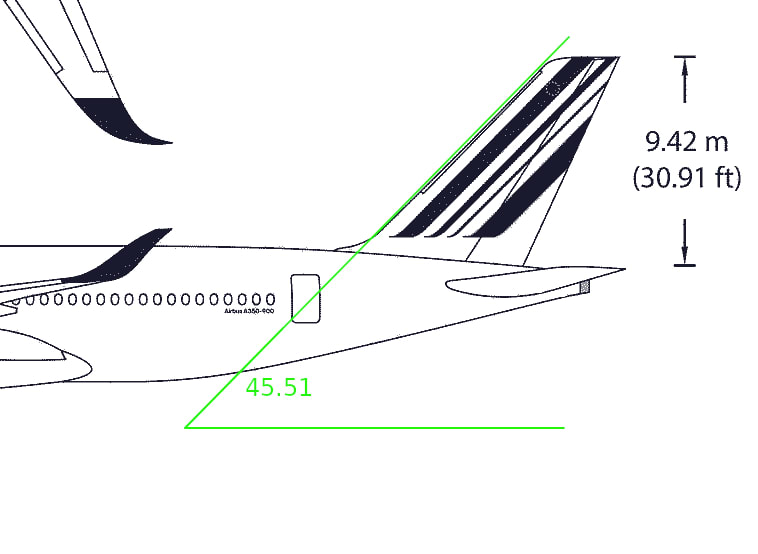
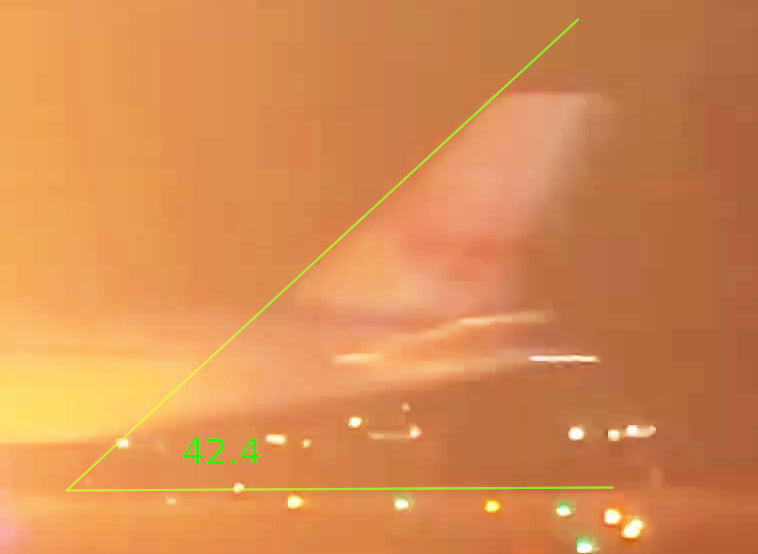
Interestingly, the passenger video from a passing jet catches the last red strobe of the A350 exactly the same as the live cam video. Couldn't ask for a better marker.
From video we can roughly find that pitch up at the time of explosion, possibly when the A350 engine shredded the Q300 wing 30 meters further down the runway, was still approx. 3 degrees.


Interestingly, the passenger video from a passing jet catches the last red strobe of the A350 exactly the same as the live cam video. Couldn't ask for a better marker.
I uploaded a synchronized video of the Tokyo Haneda live cam and the passenger footage from a passing plane taxing on Charlie just as the A350 touched down. The passenger video had two extra frames that messed up the work for a bit but once I removed them, the synchronization fell into place using the strobe and explosion lighting as markers. It provides good indication that the nose to tail strike happened immediately at the C-5 entrance to 34R with the Q300 tail being pounded down onto the runway leaving a mark and minor debris.
What is not so apparent in the passenger video is that the nose of the A350 is already through the tail of the Q300 just left of the video frame. The strobe on the A350 flashes just before the engines make contact with the Q300 wings. It's difficult to determine what damage the A350 nose gear did prior to the engine contact. What is likely is that the nose was still aloft when it made contact and the nose gear became detached from the violence of the collision.

Youtube - Tokyo Haneda collision JAL516
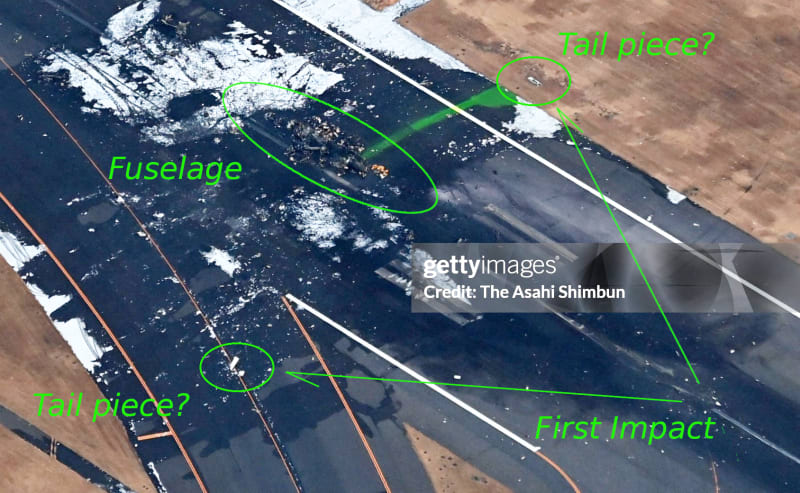
Further indications of the impact location are the debris on C-6 and more debris across the runway. The C-6 debris seems eirily similar to ribbing found in the tail as indicated by a Q300 cutaway diagram. It's more difficult to imagine the debris across the field as being another tail piece. It could also be part of a wing I suppose. If the impact sent tail debris in two directions, that would be quite something.

Debris on C-6
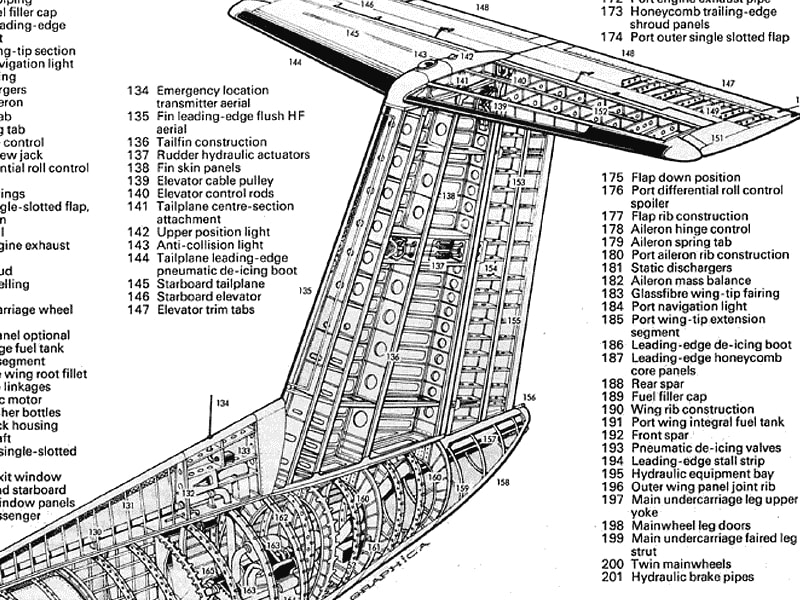

Debris across 34R
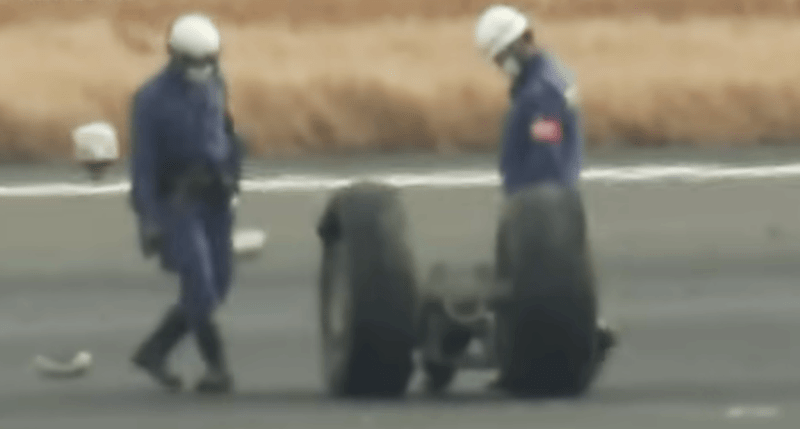
A350 Nose Gear - Location Uncertain
What is not so apparent in the passenger video is that the nose of the A350 is already through the tail of the Q300 just left of the video frame. The strobe on the A350 flashes just before the engines make contact with the Q300 wings. It's difficult to determine what damage the A350 nose gear did prior to the engine contact. What is likely is that the nose was still aloft when it made contact and the nose gear became detached from the violence of the collision.

Youtube - Tokyo Haneda collision JAL516

Further indications of the impact location are the debris on C-6 and more debris across the runway. The C-6 debris seems eirily similar to ribbing found in the tail as indicated by a Q300 cutaway diagram. It's more difficult to imagine the debris across the field as being another tail piece. It could also be part of a wing I suppose. If the impact sent tail debris in two directions, that would be quite something.

Debris on C-6


Debris across 34R

A350 Nose Gear - Location Uncertain
-
1
- #98
composite fibre...
"FAA says burning resins in Tokyo runway accident may have produced toxic smoke and took longer to extinguish.
The fuselage of the jetliner involved in a collision on a Tokyo runway was made from carbon-composite fibers, and the incident is renewing concern about the challenges of putting out fires involving the material.
The fire is shaping up as a key test of the safety of composite materials compared with conventional airplane fuselages made of aluminum.
Investigators appear to be focusing immediately on communication between the pilots of both planes and air traffic controllers at Haneda Airport. A transcript released Wednesday indicated that the landing Japan Airlines A350 had permission to use the runway but the Japanese coast guard plane did not.
Safety experts are praising the airline’s crew after everybody was able to escape the burning jetliner. Five people on the coast guard plane were killed."
-----*****-----
So strange to see the singularity approaching while the entire planet is rapidly turning into a hellscape. -John Coates
-Dik
"FAA says burning resins in Tokyo runway accident may have produced toxic smoke and took longer to extinguish.
The fuselage of the jetliner involved in a collision on a Tokyo runway was made from carbon-composite fibers, and the incident is renewing concern about the challenges of putting out fires involving the material.
The fire is shaping up as a key test of the safety of composite materials compared with conventional airplane fuselages made of aluminum.
Investigators appear to be focusing immediately on communication between the pilots of both planes and air traffic controllers at Haneda Airport. A transcript released Wednesday indicated that the landing Japan Airlines A350 had permission to use the runway but the Japanese coast guard plane did not.
Safety experts are praising the airline’s crew after everybody was able to escape the burning jetliner. Five people on the coast guard plane were killed."
-----*****-----
So strange to see the singularity approaching while the entire planet is rapidly turning into a hellscape. -John Coates
-Dik
EdStainless
Materials
Thanks Sym,
I thought that it looked like the A350 was still 'nose high' at impact but sure hard to tell.
Now we know that it was.
= = = = = = = = = = = = = = = = = = = =
P.E. Metallurgy, consulting work welcomed
I thought that it looked like the A350 was still 'nose high' at impact but sure hard to tell.
Now we know that it was.
= = = = = = = = = = = = = = = = = = = =
P.E. Metallurgy, consulting work welcomed
Alistair_Heaton
Mechanical
I doubt the A350 could see the Q300 due to the landing attitude and a single white light on the back
- Status
- Not open for further replies.
Similar threads
- Locked
- News
- Replies
- 24
- Views
- 2K
- Question
- Replies
- 12
- Views
- 14K
- Locked
- Question
- Replies
- 7
- Views
- 721
- Replies
- 24
- Views
- 7K
- Locked
- Question
- Replies
- 521
- Views
- 22K
